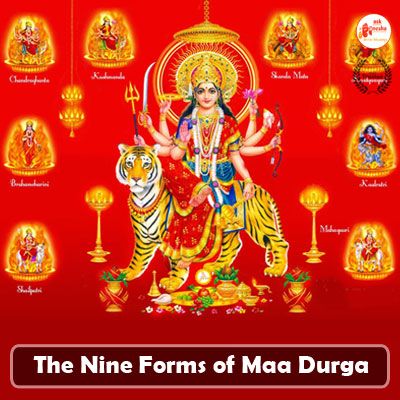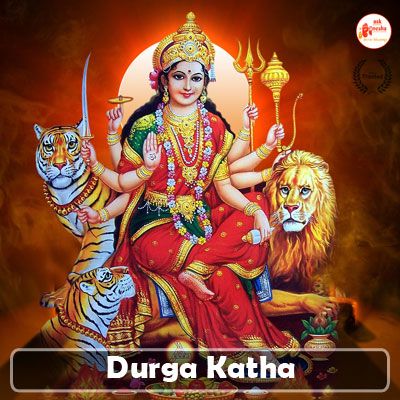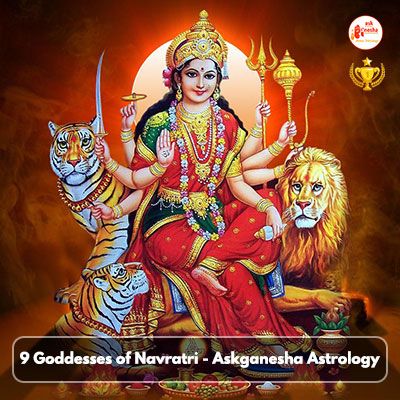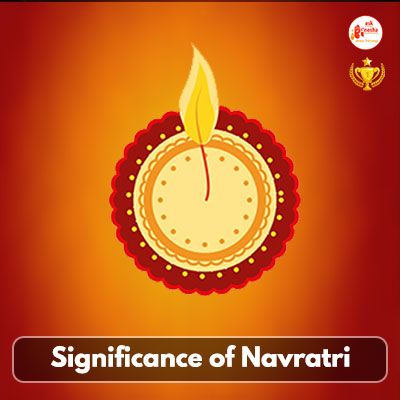Navaratri is one of the most awaited festivals of the year. I think almost everyone has some fond childhood memory attached to Navaratri. I remember collecting a basket full of fragrant white flowers for the puja at home. Having spent growing up years in the capital city was exposed to varied traditions during Navaratri. Bengalis would set up magnificent Durga pandal, people from eastern states read Durga Saptashati path, while some fast 7 days of Navaratri, grow Jayanti or perform Khetri ritual. And of course the colourful Gujarat style Dandia added to the festival fervour. Also, I distinctly remember the Navaratri Golu celebration at my Tamilian neighbour's house. It was fascinating to display on the wooden steps the statues or dolls of Goddesses Durga, Lakshmi, and Saraswati. And wooden dolls depicting characters from Ramayana, Puranas, and Dashavataram, which were passed on from many generations.
What is Navaratri or Nine sacred nights?
Nava Ratri means Nine Nights, which starts after the new moon or Amavasya day. Normally the first nine days in the Lunar cycle are feminine and the rest are regarded as masculine. Except for the 1-½ days around full moon day which is considered neutral. For this reason, Navaratri for Devi or Goddess is celebrated for 9 days after the Amavasya or New moon. In a year there are 12 New moons or Amavasyas’. And after each New Moon day, begins the 9 days time period which is regarded as feminine in nature. However, only 4 of these nine days, after the New moon is devoted to the feminine nature of the divine.
The four Navaratris’ of the Year
Chaitra Navaratri- March and April
It is the second most famous Navaratri. Similar to the Shardiya Navaratri, is a nine days long festival dedicated to Goddesses. Starts from the first day or pratipada of the first month of the Hindu Lunar calendar “Chaitra”.
Magha Gupt Navaratri- January and February
This Navaratri falls during the winter season. Also referred to as Gayatri ‘Shishir Navaratri’ Popularly known as Vasant Panchami.
Asadha Navaratri- June and July
Another Gupt Navaratri begins with the start of the monsoon.
These Gupt Navaratris’ is meant for sadhaks or Tantriks and for those observing powerful and special rituals for Shatkarma tantrik prayog (Shantikaran, Vashikaran, Uchatan, Videshan, Stambhan and Maran) These are devoted not only to 9 forms of Ma Parvati but 10 Maha Vidyas are also worshipped.
They are as follows:
Ma Tripura Bhairavi, Ma Dhumavati,
Ma Baglamukhi, Ma Kali, Maa Tara Devi,
Ma Tripura Sundari, Ma Bhuvaneshwari,
Ma Chhinnamasta, Ma Matangi and Kamala Devi.
Shardiya Navaratri- September - October
This Navaratri is considered the most important one for all Devi devotees. It is dedicated to Ma Sharada also known as Ma Sarswati, the Goddess of Knowledge. She is regarded as the Goddess of intelligence, speech, wisdom and reasoning. Those who aspire for knowledge, want to learn new things or acquire the wisdom of the spiritual path for moksha, worship Goddess Saraswati. As per Rigveda Saraswati is a feminine supreme power of knowledge with abundant healing and purifying powers
“Saraswati Namastubhyam Varade Kaamarupini
Vidyarambham Karishyami Siddhirbavatu me Sadaa”
“Salutations to Devi Saraswati, who is the giver of boons and fulfiller of wishes, O Devi, when I begin my studies, Please bestow on me the capacity of right understanding and succeed me, always.” As per Hindu scripture, those who aspire for strength, wealth, passion and knowledge worship the 9 forms of feminine power or Goddess Durga.

These nine days of Navaratri are dedicated to 9 powerful Goddesses.
Day 1- Pratipada Tithi
Devi Shailaputri, who is the daughter of the Mountain is worshipped on the first day. She is the reincarnation of Mata Sati. Also known as Mata Parvati or Gauri. Ma Shailputri is depicted as holding a Trishula in her right hand and a lotus in her left while riding the bull Nandi. The Crescent moon is adorned on her forehead. She represents Muladhara Chakra, a base chakra where the consciousness of the body resides. Yogis focus on the Muladhara chakra to take forward their 9 days of the spiritual journey. This is the reason the first day is very important as worshipping Ma Shailputri by concentrating on the Muladhara chakra our soul's consciousness awakens. Maa Shailputri is also believed to be the lord of the planet moon. Thereby eliminating all the ill effects of the Moon on the devotee.
Day 2- Dwitiya Tithi– Devi Brahmacharini
On the second day of Navaratri, Goddess Brahmacharini is worshipped. It is Ma Parvati’s yogini or unmarried form. Brahmacharini is prayed for stability, moksha, or liberation. She is cited as holding a Japa mala or rosary beads in her right hand and a Kamandala or water pot in her left hand. Devi Brahamacharini resides in Swadhisthana Chakra or Sacral Chakra, She rules the planet Mars or Mangal.
Day 3- Tritya tithi– Devi Chandraghanta
On the third day or Tritiya, we worship another form of Devi Parvati. She is called Chandraghanta, a perfect blend of beauty and courage. There is a crescent-shaped moon on her head. She is portrayed as sitting on Lion with swords in all her ten hands. Yogi focus on Manipura Chakra as a symbol of Devi Chandraghanta, She governs the planet Shukra or Venus
Day 4- Chaturthi Tithi– Devi Kushmanda
Devi Kushmanda is stated as sitting on a Lion and having eight arms. That’s why She is also known as Ashtabhuja Devi. Mata Kushmanda grants accomplishment, Knowledge, peace and prosperity. Devotees' mind is focused on the 'Anahata' chakra to seek the blessings of Devi Kushmanda. And her planet is Surya or Sun.
Day 5- Panchami Tithi– Devi Skandamata
Devi Skandamata is represented as Goddess sitting on a Lion with a baby in her arms. She has four arms or Chthurbhuj and three eyes or Tri netri. Sitting on a lion she is holding the infant form of her son Skanda on her lap. Skanda is another name for Kartikey thus she is known as Skandamata. She governs the Vishuddha chakra. Her reigning planet is Mercury.
Day 6- Shashthi tithi– Devi Katyayini
She is one of the most fierce forms of Shakti or Durga, a warrior Goddess. She has been described in Hindu scriptures as having three eyes, black hair and eighteen arms. She was born to the sage Katyayana. All the Gods had given her weapons to kill the demon Mahishasur. It is believed that a couple who does not have children, worshipping Shashti Mata Katyayani during Navaratri can bless them with a child. She also provides long and healthy life to the child of the devotee. Her blessings can be evoked by concentrating on the sixth Ajna Chakra or the Third eye chakra and her ruling planet is Jupiter or Brihaspati.
Day 7- Saptami Tithi– Devi Kaalaratri
Devi Kalaratri is another fiercest manifestation of Goddess Durga. As per legends in order to kill the demons Sumbha and Nisumbha, out of rage Parvati transformed into a dark-skinned Goddess. She is different from Ma Kali, the Goddess has fiery eyes and wears crimson clothing or tiger skin. Her vehicle is a donkey and wears a necklace that shines like the moon. Kaalratri is also known as Shubankari Mata as she always blesses are true devotees with knowledge, power and wealth. She is connected with the crown chakra or the Sahasrara chakra and She rules the planet Saturn or Shani.
Day 8- Ashtami Tithi– Devi Mahagauri
Mahagauri means extremely bright, white shining complexion like a moon. Mahagauri is the epitome of wisdom and harmony. Goddess Mahagauri is also known as Vrisharudha, as her carrier is a bull. It is believed that unmarried girls should worship Mahagauri on this day for a suitable life partner. It is again a very important tithi and its significance is attached to Chandi’s Mahishasuramardini form. On this day the energy or soul's power ascends to the Crown or Sahasrara chakra level due to seven days of meditation. It is the chakra of liberation or Moksha. Sahasrara is the last and topmost chakra of the seven chakras. It is the final step to build a connection with the supreme Self.
Mahagauri is connected to planet Rahu, the planet of desires. Rahu ignites the desire and fulfils your quest to acquire something in life. But it is a known fact that Rahu creates a feeling of emptiness as well, even when your aspiration gets fulfilled. Anyone who is able to awaken Sahasrara Chakra successfully, all his previous birth bad karmas get over.
Day 9- Navami Tithi– Devi Siddhidatri
People pray to Siddhidhatri on the Navaratri’s final day, also known as Maha Navami. Siddhi means supernatural powers or deep meditative energy, and Dhatri means bestower. As per Hindu scriptures, Lord Shiva had achieved all 8 Siddhis through his devotion to Mata Siddhidhatri. Because of this, it is believed she comes out of Shiva’s left side as Shakti and in this form, Shiva is known as Ardhanarishvara.
Goddess Siddhidatri has these eight siddhis or spiritual powers.
1. Anima– “the power to reduce to the size of an atom”
2. Mahima– “the power to rise to an enormous in size”
3. Garima– “the power to turn very heavy in weight”
4. Laghima– “the power to change into very light in weight”
5. Prapti– “the willpower to acquire anything at any time”
6. Prakambya– “the power to be able to fly or walk on water”
7. Ishatva– “power over all the elements of creation”
8. Vashitva– “the power to control all the natural forces, and power over life and death”
An example of these Sidhis would be ‘when Lord Hanuman reduced himself to a minuscule size in Lanka and also when he became a gigantic version to burn down the city of Lanka. Another example is when in the Vamana avatar Lord Vishnu transformed into a huge size and with three gigantic steps, he could cover the three worlds. Yoga and Meditation surely help to enhance the spiritual powers or Sidhis within us. On this day Ayudha or weapon Puja is also performed in some parts of India.
Planet Ketu which is considered a moksha planet is ruled by Goddess Siddhidatri. It is also believed that if a devotee worships Siddhidatri Mata with utmost devotion a person is blessed with the Siddhi and the devotee is able to recognize the existence of the powers of the Supreme Being. And it can lead him to a path of moksha or liberation. Thus on this day, Navami Homam should be carried out as per Vedic rituals by an expert priest. It is a crucial ceremony where we pray to seek her blessings and energy to live a prosperous, blissful life.






















 Translate
Translate